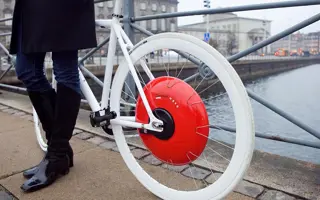News
The James Dyson Award: more than just a cash prize
While the opportunity to claim the James Dyson Award's $45,000 international prize is enticing to many, past entrants note that the competition provides a unique platform to spread the news of their designs to an international audience with many valuable potential outcomes.

Since 2004, thousands have entered the prestigious international student design competition the James Dyson Award.
For some, the prestige of the award and media coverage gained from the James Dyson Award has led to professional connections and career advancements.
The first US national winner of the James Dyson Award was Nick Poteracki from Purdue University. He designed Drop, a portable water filtration unit, and he credits winning the award for helping him land a job as a recent college graduate:
“It was easier to go out and compete for jobs. After graduating, I started interviewing for design consultancy jobs. Everyone called me back mentioning the award—it meant a lot at the start of my career.”
The 2011 US national winner and from ArtCenter College of Design graduate Seth Astle can relate. The story of his project, Cadence—a prosthetic limb and pedal system—was widely covered:
“It got a lot of publicity, and lot of people came to know the design. One company, Bespoke Innovations, saw the project and gave me an internship.”
Later, after Astle graduated, his internship turned into a full-time job.
Eventually, in 2012, Bespoke Innovations was acquired by 3D Systems. Astle continues to work there and now leads the design team. He credits winning the James Dyson Award for paving the way to where he is today:“I thought, ’If I can do this project and win this award, think about all the difference I can make in my future.’ The projects I can make to improve people’s lives drives me to push my limits, create and innovate,”For other past participants, winning the James Dyson Award meant exposure that helped open doors to pursue further product development:“The award was a nice feather in my cap for my senior project at school and brought me more attention from various press outlets.”2007 US winner and then California College of the Arts student Matthew Gale’s patent-pending design, Excubo, is a jacket designed to help travelers sleep more comfortably on planes, buses, subways and other public transportation. After winning the award, he secured a loan to pursue further product development and has continued to work in the design field in New York City, most recently in eyewear and menswear.Product development, as Gale knows, is a time consuming process, and the 2010 US national winners, the Copenhagen Wheel team, know this, too, from firsthand experience:“It’s a process of finding funding, growing the team, producing prototypes, and finding a manufacturer,”After being announced the US national winner for the James Dyson Award six years ago, the Copenhagen Wheel quickly caught the interest of bicyclists, design enthusiasts, technology buffs and more:“We got a ton of press and a lot of interest in our product.”One of those interested in learning more was the director of the 2005-2012 Showtime TV series Weeds:“They wanted to feature our bike in an episode, and it ended up being a number of episodes.”The 2013 International James Dyson Award winner from Titan Arm were were contacted by CNN, the Wall Street Journal, the Times, Popular Science, and many other media outlets:“The JDA was fantastic for exposure, we got more eyes on the Titan Arm website, and more and more of the public got in touch with us to talk about potential applications.”Titan Arm team member Nicholas McGill mentioned that the exposure Titan Arm received after winning the award connected him with his future employer at a product design firm.For Kai Lin, a national finalist for the 2014 James Dyson Award with his design for Klippa, the media coverage of his prosthetic leg designed for rock climbers created a lasting buzz within the rock climbing community:“I was recently contacted by film makers who were interested in documenting my project.”The film makers asked Lin to collaborate with them and a rock climbing amputee in Colorado. They plan to document the process of Lin creating a customized Klippa to help the man achieve his goal of climbing the tallest mountain in Colorado.
Like many other finalists and winners, Lin said a lot of buzz had been generated about his design as a result of the media coverage from his participating in the James Dyson Award. “I gained a lot of traction because of the award,” he said.
Copenhagen Wheel’s Outram shared a similar sentiment:“The James Dyson Award impresses people, It’s a nice validation of what (the Copenhagen Wheel team) were trying to achieve, in terms of a refined project that not only worked well but was beautiful. It is a combination of practicality meets design or meets beauty, and I think that’s what people see the James Dyson Award as also representing.”
